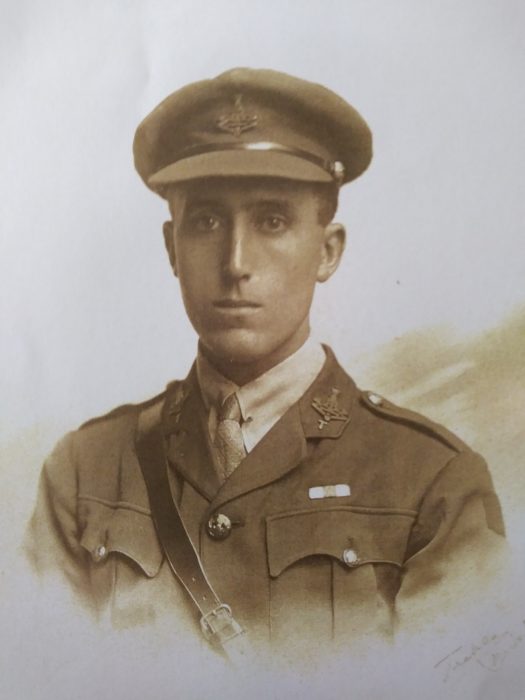
Ruth Kendon came into the museum and told us the story of her father, Reginald Howes.
Reginald Howes (1889-1977) attended the University of London Officer Training Corps (OTC) between 6 May 1915 and 20 July 1916 before being commissioned as a 2nd Lieutenant in the Yorkshire Regiment on 21 July 1916.
He served with the 4th Battalion as temporary Adjutant and Intelligence Officer, and was wounded on 15 September 1916 at Kemmel, just south of Ypres. Ruth remembers him saying he was wounded on the day tanks were first used.
Howes was awarded the Military Cross in March 1918, for “conspicuous gallantry and devotion to duty” on the Somme, during the Kaiserschlacht offensive and promoted to Captain the following month. He was taken prisoner on 27 May 1918 and released on 14 December 1918.
Ruth kindly donated a number of items which belonged to her father to the museum for safekeeping.
Explore more memories from the ribbon
-
Harold Moore
Harold Moore was born around 1898 at Mirkport near Hawes, with his twin sister Hilda. He was the second youngest of a family of ten children to Richard and Mary Moore. In 1901 they were living at Mirkpot Farm on the Hawes-Ingleton road where Richard was a farmer and stonemason. By 1914 they were living at Catriggs Farm near Hawes. Harold enlisted in Leyburn in May 1918 joining the 9th Battalion Yorkshire Regiment. He arrived in France on October 11th, just one month from the Armistice and the cessation of hostilities. As Harold joined his Battalion, it had just come out of front line action in the Premont area between St. Quentin and Cambrai. A week later on the 24th October the Battalion was involved in capturing a machine gun post in a wooded area. During this action Harold, along with a number of other casualties, was severely wounded and later died. He had been in the war just 13 days. Private Harold Moore is buried in the Premont British Cemetery SE of Cambrai. He was just 20 years old.
-
Captain John Maughan
John was born on the 4th January 1890 at East Witton in North Yorkshire and was the eldest son of John and Annie Maughan. They lived at Abbey Hill, a large house overlooking Jervaulx Abbey near Middleham, North Yorkshire. John senior was the agent for the Jervaulx estate. John was educated at Marlborough College. He was gazetted to a commission in the 4th Battalion, The Yorkshire Regiment in 1909 and was promoted Captain on the 3rd November 1914. John went to France in April 1915 and was in action at the 2nd Battle of Ypres just a few days later. His distinguished service during this action resulted in him being ‘Mentioned in Dispatches’ by Sir John French. On the 12th February 1916 the Battalion occupied trenches around Hill 60 near Ypres. Work was ongoing repairing trenches when on the 14th February the Germans began to bombard them. The enemy also exploded a mine which killed thirteen men. On the 17th February, ironically regarded as a relatively quiet day, some minor shelling resulted in John being hit and killed by shrapnel. Captain John Maughan was buried in Poperinghe New Military Cemetery. John’s name is commemorated on the War Memorial at East Witton.
-
Marguerite McArthur
Marguerite was born on the 25th March 1892 in Kensington London. From an early age she had a love of books. She attended Norland Place School in Notting Hill. It was soon apparent that she was academically gifted. She also excelled at sport, especially Hockey. During the war years she became Honorary Secretary of the Norland School Old Girls Association. Marguerite left school in 1908 and went on to higher education attaining First Class honours at the Cambridge Higher Local with a distinction in history. In 1910 she went to Dresden in Germany to study culminating in First Class Honours again with a distinction in spoken German. She was also fluent in French. In January 1911 went to Canada in what was a combines holiday/studying venture. October of that year would see her entering Clough Hall Newham College Cambridge to study further in the German language, again attaining First Class honours. At the outbreak of war Marguerite was employed by the Young Men’s Christian Society (YMCA). The Society had been established in London in 1844 as a prayer and bible study group. At the outbreak of war it turned their attention to providing support for servicemen. In November 1914, working with the BEF, it established centres in France. By 1918 there were over 300 centres. Marguerite would find herself working in the War Office Translation Bureau because of her language skills. From March 1918 Marguerite was part of the Army Education Service of the YMCA at Etaples on the northern…
